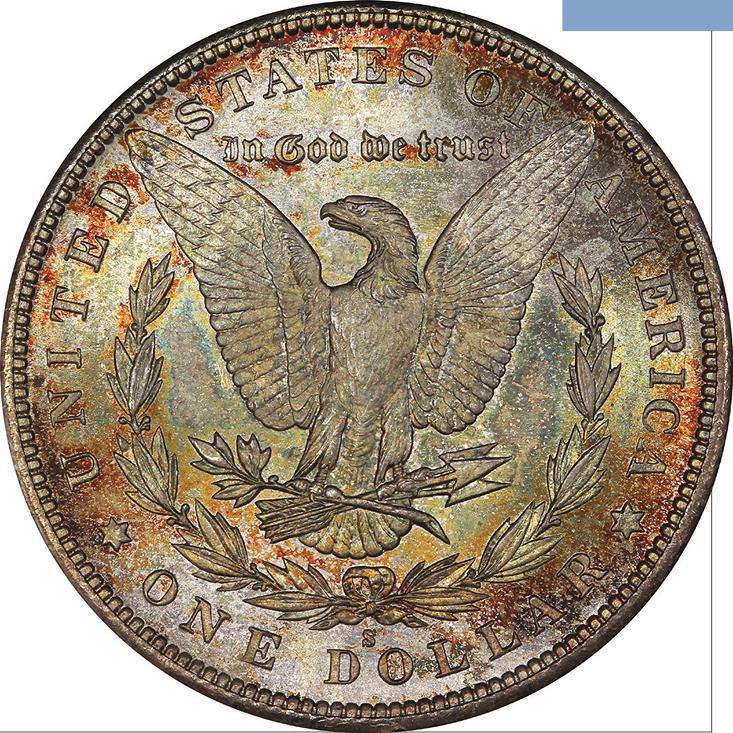



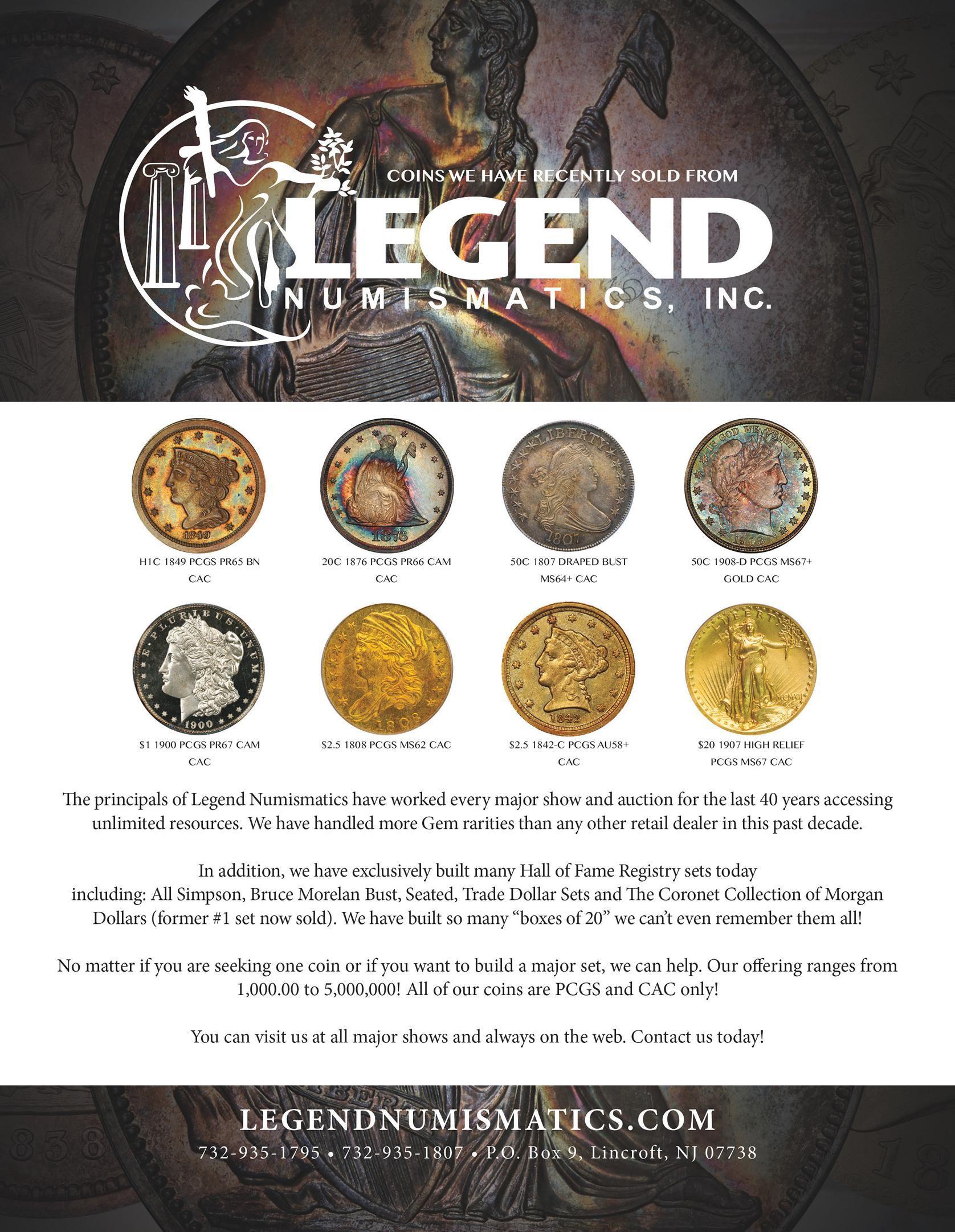








A Collectors Universe Company • NASDAQ: CLCT www.PCGS.com
Editor-in-Chief Michael Sherman
PCGS Price Guide Editor David Hall
Advertising Director Rebecca Tran Pricing Specialist Jaime Hernandez
Managing Editor Ta’Cora Burgess Graphic Designer Darnell Dialls Copy Editor Ryan Delane Technical Liason Type “F” Numismatic Photographer Phil Arnold
Subscriptions:

Single Issue: $14.95 One-Year Subscription (6 Issues): $79.99
RCMR is offered as a premium to PCGS Authorized Dealers and PCGS Collectors Club members.

To become a PCGS Authorized Dealer, contact: Sandy Locker, PCGS Dealer Liaison P.O. Box 9458, Newport Beach, CA 92658 949-833-0600 Extension 131
To become a PCGS Collectors Club member, go to www.PCGS.com/join
Printed in the United States. Copyright 2017 Collectors Universe, Inc. All rights reserved. Reproduction of any kind without written permission of the publisher is prohibited by law. PCGS Rare Coin Market Report is published bi-monthly by Collectors Universe, Inc. at P.O. Box 9458, Newport Beach, CA 92658. Postmaster, send address change to Rare Coin Market Report c/o PCGS, Publication Department, P.O. Box 9458, Newport Beach, CA 92658.
Publication of this magazine is not a solicitation by the publisher, editor, or staff to buy or sell the coins listed herein.
Advertisements, articles and the PCGS Price Guide section of this magazine sometimes contain inadvertent typographical errors, a fact readers should bear in mind when encountering pricing quoted at a fraction of prevailing market values. The publisher is not responsible for actions taken by any person because of such errors. Advertising prices are subject to change without notice.
Welcome to the second issue of the new Rare Coin Market Report. This issue is quite an interesting one, for we’ll be talking a look at the “Milestone” coins that broke important pricing thresholds over the past 165 years or so. Our feature article will take a look at these seven important coins and provide photos and details of their sale.
The incomparable Q. David Bowers will be offering his recollections on the last three of these milestone sales. His firm(s) sold the final two coins on the list, and he was closely involved in the sale of a third. And as another treat on this subject, none other than Bruce Morelan, owner of at least three (and arguably four) of the coins on this list will share his thoughts and observations about bidding on, and owning so many of these important coins.
Our Set Registry spotlight this month falls on Dr. Lawrence Brown, perhaps better known to Registry followers as “ErasmusHall.” The winner of 18 PCGS Gold Awards, Dr. Brown specializes in modern Proof issues, and was inducted into the PCGS Set Registry Hall of Fame at the August ANA convention in Denver. His 1936-Present Proof Set boasts a rating of an incredible 69.81 and has dominated that important category for seven years.
PCGS CoinFacts™ President and noted numismatic writer Ron Guth will discuss overstrikes (coins struck on top of earlier coins) and address the many interesting aspects of this fascinating area.
We also welcome a new author to this issue. Owen Seymour, a nineteenyear-old dealer from Pennsylvania will share the story of how he became professionally involved in the business and offer his observations on the future of the hobby. If you haven’t guessed already, much of it will be online!
Since our last issue, several major auctions were held during the ANA convention, and results of these (as well as other sales held from July through September) will be reflected in our pricing section. It’s hard to call a trend, as prices were both up and down – but rarity and quality in highly collectible series usually pays off in the long run.
We hope you enjoy this issue, and be sure to check out our new “feedback” box below left on this page.
Michael W. Sherman Editor-in-Chief


11 Milestones - Counting Down from the First 8 Figure Coin Purchase
Takeacentury-and-a-halftripwithusaswejourneybacktoseetheMilestones–coins that“addedazero”totheauctionpricerecordforaU.S.coin.
26 How to Use the Price Guide
27 PCGS Grading Standards
Noted numismatic author Ron Guth examines what happens when an old coin is used to strike a new one – usually with very interesting results!
Nineteen-year-old dealer Owen Seymour offers his perspective on the current state of numismatics among millennials and his thoughts on the future of the hobby.
PRICE GUIDE: Half Cents 31 Cents 33 Two Cents 54 Three Cents – Silver 55 Three Cents – Nickel 57 Nickels 58 Half Dimes 68 Dimes 71 Twenty Cent Pieces 85 Quarter Dollars 85 Half Dollars 101 Dollars 114 Gold Dollars 129 Quarter Eagles ($2.50) 131 Three Dollars 137 Stellas ($4) 138 Half Eagles ($5) 138 Eagles ($10) 145 Double Eagles ($20) 150
Commemorative Coins Vintage (1892-1954) 154 Modern (1982-Date) 157 Bullion Coins 158
1893-S Morgan Dollar | PCGS MS67 CAC Vermuele-Lee-Coronet Specimen
What else can be said about our cover coin other than it is the most valuable and desirable coin in one of the most popular and widely collected series in U.S. Numismatics? Well for starters, its condition is nothing short of superb, with incredible original toning over nearly flawless surfaces. It has appeared in auction only once before, in 2001, when it was purchased by noted silver dollar collector Jack Lee and it is set to return to the auction block on October 26, 2017 in Legend Auctions' Regency XXIII in Philadelphia.


Amillion dollar coin? Who would have thought such a thing years ago? My experience with classic American rarities dates back a long time, almost to the Stone Age when it comes to pricing. In 1957 I paid the record price of $4,750 for an 1894-S Barber Dime offered by Stack’s as part of the Empire Collection. This news was absolutely sensational, was carried nationwide in newspapers and magazines, and landed me a guest appearance on the NBC Today Show. Now, in 2017, a $4,750 coin of any kind would not merit even a footnote in an auction or convention report. With regard to the 1894-S Dime, my 1957 purchase, which was sold to Emery May Holden Norweb soon after I bought it, would easily cross the million-dollar mark.
In the same vein I remember in the late 1950s that Yale University desired to sell an MCMVII (1907) Ultra High Relief Double Eagle, a beautiful Proof, from a mintage of slightly more than 20 coins. They were asking $18,000 for it, but there were no takers and it had been rejected by at least two dealers. When it was offered to me, my partner, Jim Ruddy and I, owners of the Empire Coin Company, thought it to be a good buy and snapped it up. Speaking of this particular variety, some years later in the 1970s I had an example and sold it to Steve Markoff, owner of A-Mark Coin Company, for more than $100,000. As we were completing the transaction in my office, he said something like, “Stop! I want to call my father because I told him if I ever paid more than $100,000 for a coin I would let him know.” Steve got his dad on the line, and a minute later the transaction was completed. Today in 2017 MCMVII Ultra High Relief double eagles have sold for more than a million dollars on multiple occasions, and have even crossed the $2 million mark several times.
Changing the drift somewhat, I go to the most valuable coin in numismatics at this time – based upon the auction price. The spotlight is on the Cardinal Collection 1794
Silver Dollar, certified as Specimen-66 by Professional Coin GradingService.OfferedbyStack’sBowersGalleriesinNew York City on January 24, 2013, it attracted a lot of pre-sale attention. That evening, with a gallery filled with bidders, plus internet and phone activity, and with Melissa Karstedt at the podium, the coin opened at $2.2 million. From there it went up step by step, with much excitement along the way, until Melissa cried, “Sold for $8,525,000!” With the buyer’s fee added, the total price came to $10,016,875. The buyer was none other than Laura Sperber, well-known dealer and longtime friend, who was acting on behalf of her client and also a fine friend of our company, Bruce Morelan.
ThispromptsmetosaythatStack’sBowersGallerieshas been a focal point for notable 1794 Dollars. On September 30, 2015, at Part II of the D. Brent Pogue Collection sale, we offered Lot 2041, a gorgeous Lord St. Oswald 1794 Flowing Hair Dollar certified as Mint State-66+ and with an ownership history that could be traced back to 1794. Our sale was held in coordination with Sotheby’s at their International Headquarters in New York City. Again, the gallery was filled with enthusiastic bidders, augmented by a bank of telephones and internet bidding. Excitement prevailed when the coin was sold for $4,993,750 (including buyer’s fee), a record for that grade.
Wait, there is more! Recently, at the American Numismatic Association World’s Fair of Money in Denver, we offered lot number 2113, a 1794 Flowing Hair Silver Dollar graded MS-64 by PCGS, a familiar face as I had cataloged it as part of the Norweb Collection in our auction of November 1988. Once again, excitement prevailed and it went to a new home for $2,820,000 (including buyer’s fee).
Silver dollars of 1794 have always been of special interest. In November of that year, 1,658 pieces were released into circulation. A few seemed to have been kept by Mint officials or others, accounting for a handful of Mint State pieces, including the record-breaking Cardinal Collection coin.

“Sold for $8,525,000!”Melissa Karstedt hammers the first eight figure coin on January 24, 2013

In the late 1850s when coin collecting became a popular hobby, the 1794 Dollar was recognized as being rare. Pieces could occasionally be found in bank deposits, and alert tellers picked them out, selling them for several dollars each or more. As time went on the fame of the 1794 Dollar increased, as did the price. In the 21st century, even a wellworn specimen is apt to sell for more than $100,000. The exact number of 1794 Dollars known to exist seems to be about 140 different, ranging from Fair or About Good (still a very desirable grade for this rarity), to the famous Cardinal Specimen.
Another record-breaking memory is from May 1996, when we sold the second of what would turn out to be four auction sales of the Louis E. Eliasberg Sr. Collection. Held in New York City, this sale included copper, nickel and silver coins through the lower denominations. A highlight was the 1913 Liberty Head Nickel, the only one of the five known examples that I considered to be a Proof. It was described in the sale catalog as Gem Proof-66 and the finest known. The bidding opened in the high hundreds of thousands of dollars, jumped, and went up, up and up again, crossing the million dollar mark, the first time in worldwide numismatic history that such a price had been attained. When all was said and done, the coin realized $1,485,000 (including buyer’s fee.) The buyer was Jay Parrino, whose company, The Mint, handled many rarities in this era. Excitement prevailed. Many in the audience stood up and applauded and I had to stop the sale for five minutes or so. It was a memorable experience.
Today, in looking at the auction price records section of the 2018 edition of the Guide Book of United States Coins, I see that there are 93 coins that have crossed the block for $1 million or more, topped by the Cardinal Collection 1794 at $10,016,875. And that doesn’t even include a number of D. Brent Pogue Collection coins sold by Stack’s Bowers Galleries since that compiled. Wow! Wow again! Back in 1996 with the first coin crossing the million mark, who could have imagined the total 21 years later!
As I contemplate my company having sold the first $1 million coin and then the first $10 million coin, I cannot help but think and hope I will be on hand for the first $100 million coin! Time will tell.
In the meantime, I will enjoy numismatics to its fullest extent as I have since I was a teenager. How lucky we all are to be part of what I, and many others, call the world’s greatest hobby.




Nearly five years ago, the numismatic world was electrified by the sale of the first coin to bring over $10 million. As the gavel came down on lot 13094 at Le Parker Meridien in New York City, everyone in the audience realized that another major milestone in numismatics had just been passed, and that it would likely be quite some time until we see the next.
From its humble beginnings in the early 1850s through today, the price record for a U.S. coin has “added a zero” six times, or an average of once every 27 years. Some intervals have been fairly long (1885 to 1941), while others have been considerably shorter (1851 to 1862) but nearly all have been newsworthy events in the hobby.
For the most part, the milestone coins have been the usual suspects, such as the 1794 and 1804 Dollars, the 1913 Nickel or the 1822 Half Eagle. However the earliest mid19th century milestones highlighted the intense collector interest in colonials that dominated U.S. numismatics until shortly after the Civil War.
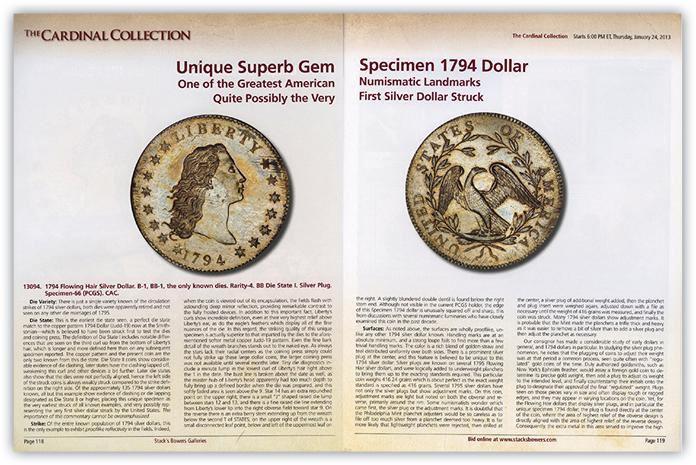

As numismatics grew rapidly during the 1880s and 1890s, interest turned to the more exotic ultra-rarities that more often than not, were fantasy restrikes, patterns or unauthorized strikes or releases. By the 20th century, these types of issues held nearly all of the price records. There is just no substitute for an “original mintage” of fewer than a dozen or so pieces to quicken the pulses of numismatists.
Our study will confine itself to public auction records as they are verifiable and considerably more reliable than reports of a private transaction. However, at the conclusion of this article, we’ll mention some noteworthy private sales. In particular, Abe Kosoff’s October 1972 sale of the Olsen-Hydeman 1913 Liberty nickel to Worldwide Coin Investments has a legitimate claim to the six-figure title.
So join us as we take a journey back through time, and recall the great milestones of the past...
That the most valuable United States coin would also likely be the first silver dollar struck is entirely fitting and proper. Many of the greatest U.S. rarities were never really struck for circulation (1913 Liberty Nickel, 1894-S Dime and 1804 Silver Dollar), and while they have held great allure for numismatists for many years, there is something satisfying about the present crown belonging to a real coin.
The Stacks-Bowers cataloger commented: “certainly one of the greatest rarities what we have ever handled, this in our cumulative auction experience dating back to 1935. The coin is indeed legendary, one of its kind, and boasts great historical and numismatic significance.”
If milestone coins were to be found, where better to find them than in the greatest collection of U.S. coins ever assembled: the collection of Louis E. Eliasberg. Mr. Eliasberg achieved what today would be next-to-impossible – a complete collection of U.S. coins.
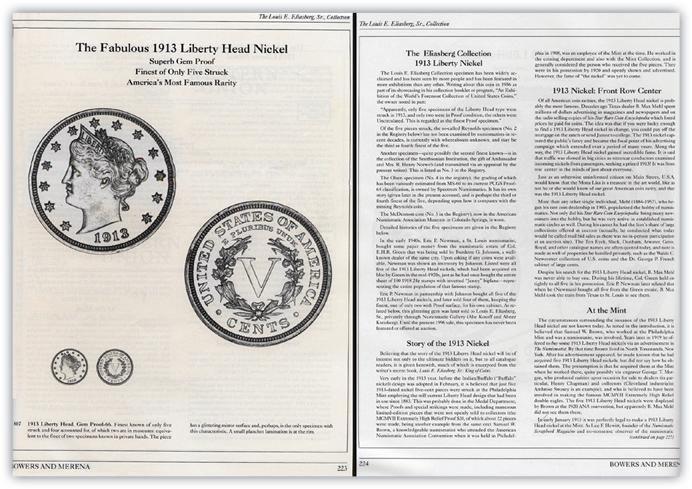

Since their ‘discovery’ in 1919, the five 1913 Liberty Nickels have intrigued the numismatic world. It was a rather ordinary looking coin of the type commonly found in circulation throughout the first half of the 20th century and achieved a modest amount of fame through B. Max Mehl’s advertisements to purchase another (which he almost certainly knew was not about to happen).


It came as no surprise when the finest of the group cracked the million dollar barrier.
When Englishman William Strickland visited the newly-formed United States of America from September 1794 through July 1795, he returned with a group of 84 coins, including some examples of the first Federal coinage, no doubt struck during his visit.
After his return to England, the coins came into the possession of Rowland Denys Guy Winn, a longtime member of the House of Lords, who might be better remembered today as Major the Lord St. Oswald. For the next 170 years, this group would remain intact in the family’s collection.
A fortuitous turn of events to be sure, for today some of the finest examples of our nation’s first coinage share this prestigious pedigree.
Like the 1794 Dollar, here is another coin actually struck for circulation, and in this particular coin’s case, it indeed circulated – albeit rather briefly. Some 17,800 pieces were originally struck, making it by far the most “common” of the milestone coins. But in the decade after they were struck, the price of gold as reckoned in silver increased, driving the melt value of U.S. gold coins above their face value. And into the pot they went – almost all of them.
Somehow, three examples of the 1822 Half Eagle escaped, and the rest is history. Mehl called it “the rarest and most valuable coin of the entire United States series,” and on June 3, 1941, that statement was proven correct.

The 1804 Silver Dollar. Books have been written about it, and the coin has enjoyed almost mythical status for a century and a half. However, as late as 1834, there were no 1804 Silver Dollars in existence. After a request from the State Department for diplomatic gifts, the Mint produced a small group of seven silver dollars dated 1804.
Following the 1842 publication of Eckfeldt and Dubois’ Manual of Gold and Silver Coins of All Nations that ‘illustrated’ a dollar dated 1804, demand from the handful of active collectors resulted in some additional strikings in the late 1850s and early 1860s.
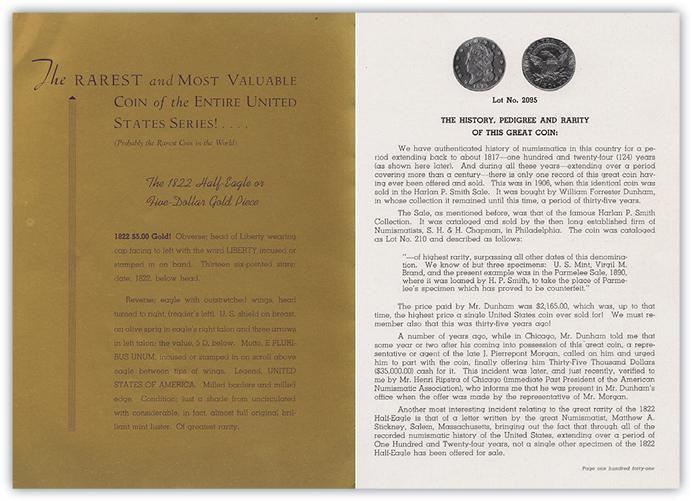

Since that time, the silver dollar of 1804 has remained near the top of the list of American numismatic treasures.
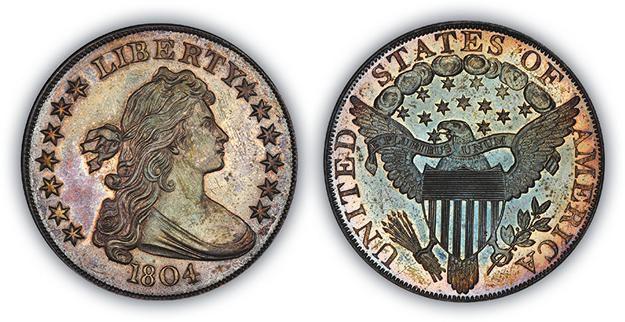
Prior to the Civil War, the most valuable coins to be foundinU.S.coinauctionswerestruckpriortothebeginning of our regular issue coinage in 1793. George Jones’ Coin Collectors Manual, the first publication dedicated to U.S. coin values, included a list of the most valuable coins of the 1859-60 period. Nine of the top ten were either colonials or the patterns of 1792.

Remember that during the 1840s and 1850s, many of the older collectors could remember spending the earliest regular issue U.S. coins – so we can perhaps forgive their lack of enthusiasm for Chain Cents and Flowing Hair Dollars.
We are uncertain if the coin shown above is the exact coin from the Finotti Sale, but we believe the odds are pretty good that it is.
Finding the first two-figure coin wasn’t easy, as the very earliest U.S. coins offered at public sale were not well-documented. It is widely accepted that the first U.S. auction primarily dedicated to rare coins and medals that attracted nationwide attention was the collection of Dr. Lewis Roper, sold by Thomas and Sons on February 20, 1851 in Philadelphia.
The star of the sale was the “Half Dollar with the head of Washington 1792” which realized the enormous price of $18.


While it’s certainly possible that some U.S. coins sold for more than $10 prior to this time, this is likely the earliest documented sale extant. See the note on the next page discussing other possibilities for the earliest two-figure record.
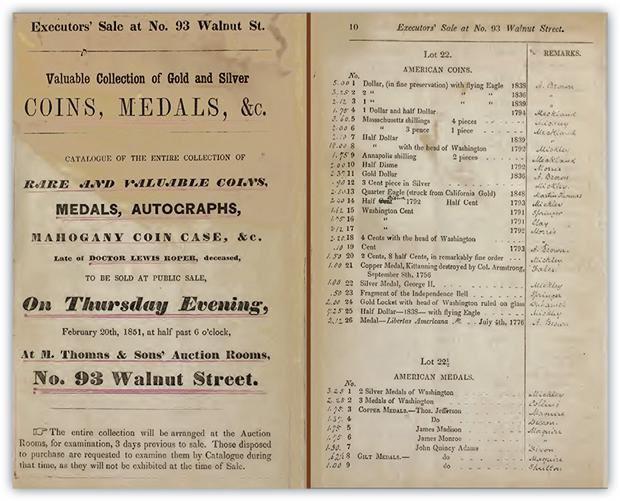
Some believe this honor belongs to the Olsen-Hydeman Specimen of the 1913 nickel, which was purchased by Worldwide Coin Investments, Ltd. in early October, 1972 from Abe Kosoff. It was purchased along with the Idler Specimen (Class III) 1804 dollar and a check for $180,000 was tendered for the two pieces. Worldwide billed the nickel as the first $100,000 coin and publicized the purchase extensively in the press.
William Woodin purchased the two 1877 Gold Half Union ($50) patterns from Capt. John W. Haseltine and Stephen K. Nagy for the sum of $10,000 each in early 1909, but returned them to the Mint the following year in exchange for other patterns after pressure arose from the U.S. government.
A Class III 1804 dollar reportedly changed hands from Robert Coulton Davis to John W. Haseltine ($1,050) and from Haseltine to George M. Klein ($1,200) in 1883.
Another early three-figure sale was an 1827 quarter (original) sold for $225 in William H. Strobridge’s Seavey Sale, in September, 1863.
Obviously any Eagle which traded prior to 1851 may have sold at a small premium over its face value. Also, Matthew Stickney received $10 value in compensation (including his 1804 dollar) in his famous trade with William DuBois in 1843 for the unique Immune Columbia piece in gold.
Acknowledgments are due to the following people for their assistance, advice and suggestions:
Michael Sherman is the Editor in Chief of the Rare Coin Market Report and the Director of Education for PCGS.


Email: msherman@collectors.com
Milestone coins — what a great subject! Every so often, a coin soars to new heights and breaks a price record on a nice round number that we all remember. Almost exclusively, these coins are the “stuff that (numismatic) dreams are made of.” I’ve been fortunate throughout my collecting career to have owned four of these amazing specimens.
First and foremost among them is the Carter – Cardinal 1794 Dollar. My record-setting bid resulted in it becoming the first coin to ever exceed the $10 million mark. Why is it worth so much? Because it belongs in a museum as the first dollar ever struck for the fledgling United States of America — which incidentally also makes it the first one figure milestone coin. Ha!
IalsohaveownedtheEliasberg1913LibertyHeadNickel — the first coin to break the $1 million barrier. I purchased the coin from John Albanese on a verbal ‘done deal’ and held it in my collection for several years until finally selling it. An interesting side note is that when retrieving the coin from the safe deposit box storage, I was handed the wrong box and was dumbfounded to find it empty! My jaw dropped open as I contemplated the loss of a $5 million coin! Fortunately, I noticed the real box on the attendant’s desk before my heart completely stopped and all was well.
Speaking of 1913 Liberty Head Nickels, the next milestone coin that I’ve owned is the Hawaii Five-0 (OlsenHydeman) specimen. It is the first coin to break the $100,000 barrier — albeit in a private transaction. I purchased the coin in the early 2000s with the goal of owning all the ultra rarities at the same time. When it came time to build the finest Seated Dollar set, I modified that goal to owning all of the rarities at SOME time. I pretty much have accomplished
Last but not least on the milestone list is the aforementioned Dexter specimen of the Class I 1804 Dollar. These so-called originals were minted in 1834 for use in presentation sets for foreign dignitaries. It was the first coin to break the $1,000 barrier when it sold for exactly that in 1885. It also very nearly became the first coin to break the $1 million barrier when it sold for $990,000 in Rarcoa’s August 1989 sale. I can guarantee that, if I had been the winning bidder at that time, I’d have made sure it reached the mark! One interesting side note is that a previous owner also resided in Spokane for much of his adult life — very small world!
It’s been my privilege and pleasure to have owned these coins over the years. Each one is a numismatic treasure. I can’t wait to see which new specimen will be the one to break the next barrier and add its name to the list!
Q. David Bowers Dr. Joel J. Orosz P. Scott Rubin David Stone Bruce Morelan David Hall
Whether or not one believes that human beings are reincarnated, there is no denying that reincarnation exists in numismatics. Simply put, not all coins start out life as a blank planchet. Sometimes an old coin is repurposed and overstruck with new dies. In many of these reincarnations, remnants of the old coin remain visible when the pressure used to strike the new coin is not strong enough to obliterate the old designs. In many cases, there is enough evidence of the old coin to make a positive identification. In other cases, only traces of the old coin remain.
Overstriking can occur for a number of reasons: accidental; political; monetary, and economical. In some cases, one or more of these reasons might apply, as shall be noted below.
over Roosevelt Dimes, Franklin Half Dollars struck over Lincoln Cents, and many other odd combinations. What about accidental overstrikes of the same denomination? One of my favorite overstrikes is a Proof 1970S Washington Quarter struck over a 1900 Barber Quarter from Philadelphia. How “accidental” was that?
Accidental overstrikes are seen frequently in the field of error coins. Accidental overstrikes occur when a previouslystruck coin is refed into a press for a different denomination. These “dual-denomination” coins are quite rare and they are very desirable. Examples include Jefferson Nickels struck

Political overstrikes occur when an incoming ruler or administration overstrikes the coins of the previous ruler or administration. This is done to either obliterate the memories of the past, to take advantage of a ready supply of “planchets,” or both. The coin listed above is an example of the new Spanish monarch, Ferdinand VII, wiping out the coins of the old monarch, Charles IV.
Monetary overstriking is done to revalue the currency by giving the new coin a value that is greater than the old (which raises a good question, “Has there ever been an instance when a new coin was given a lower value?”). Monetary overstriking was a common practice in some countries where inflation ran rampant, but it has never occurred on U.S. coins because our monetary system has never been officially devalued.

Economical overstriking occurs when it is simpler and less expensive to overstrike an old coin than to go through the process of obtaining raw metal and preparing it for coinage. Examples of economical overstriking include the 1797 Half Cents struck over Talbot, Allum, and Lee tokens of the 17941795 era. In 1797, the U.S. Mint was having a hard time sourcing good copper. The New York firm of Talbot, Allum & Lee purchased a large supply of custom-made, advertising tokens from England and found themselves with more coins than they could give away. They needed to sell, the Mint needed to buy, so a deal was struck. The Mint cut the Talbot, Allum, and Lee One Cent pieces down in size and used them as planchets for Half Cents. Thus, many 1797 Half Cents, especially those of the 1 above 1 variety, still show traces of the ship’s rigging in varying degrees; some rare ones still retain some of the edge lettering from the English tokens.



Here are some of the more interesting overstrikes that can be found on U.S. and related coins. Keep in mind that this is just a partial listing – an entire collection could be devoted just to overstrikes.
The 5 and 9 of the 1859 date are much larger and can be seen to the right of the 1838. Is there any doubt when these restrikes were made?
This is an unusual, dual-denomination overstrike. This was not a case of a monetary revaluation; rather, it was an economical re-use of a coin that might have been underweight or damaged.


This is a case of one company using another company’s coin as a planchet. Traces of the original lettering can be seen on both sides, including J.S.O. (for J.S. Ormsby) on the obverse and DOLLS (for Dollars) on the reverse. This seems to by a hybrid political/economical use where one company obliterates the coin of a competing firm.
 The New Jersey Copper series is replete with overstrikes using a variety of host coins, including Connecticut Coppers, imitation British Halfpennies, Machin’s Mills Halfpennies, Vermont Coppers, and George Clinton Cents. On this coin,
The New Jersey Copper series is replete with overstrikes using a variety of host coins, including Connecticut Coppers, imitation British Halfpennies, Machin’s Mills Halfpennies, Vermont Coppers, and George Clinton Cents. On this coin,
the 1787 date of the Connecticut Copper is clearly visible on the upper left side of the reverse. In some cases, so much of the detail of the host coin remains that researchers can actually identify the die variety. Clearly, the date on this 1786 New Jersey Copper was meaningless.
was
This is a 1797 Half Cent struck over a cut-down 1798 Large Cent, with the date of the Large Cent clearly visible on the obverse. Because the date of the Large Cent was later than that of the Half Cent, one might believe that the Half Cent was the host coin, but such is not the case – the Large Cent definitely came first. This is another illustration of the

economic realities of the early U.S. Mint – they could not afford to waste any of the copper that came their way.

Two overstruck coins in the National Numismatic Collection at the Smithsonian Institution deserve special mention. One is an 1804 Silver Dollar (Class II) struck over an 1857 Swiss Shooting Thaler. By supplying a world coin of the appropriate size and weight, the minter of this coin bypassed the strict accounting controls over the silver bullion at the Mint. The other coin is a 1785 Immunis Columbia struck over a 1775 British Gold Guinea. In 1843, Matthew Stickney traded this unique coin for an 1804 Silver Dollar. Overstruck coins offer an unusual collecting niche. Many overstrikes are very affordable despite their unique appearance and the odd circumstances under which they were made. If you’re looking for new excitement in numismatics, start your collection of overstrikes today.
Ron Guth is President of PCGS CoinFacts. He has been active as a coin collector, dealer, writer and auctioneer since his introduction to numismatics in 1964. Email: rguth@collectors.com





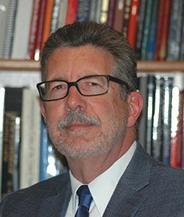
 By Mark Stephenson
By Mark Stephenson
Welcome again to From the Desk of the VP. In the inaugural piece for this column, I set forth some of my goals for future versions. We will use this space to present significant events happening or coming up in the coin industry and at PCGS, and share market insights that I’m hearing from the market makers.


The Long Beach Expo just concluded as of this writing. The show was a tremendous success, featuring several very cool attractions. The McVey Collection’s Canadian dollar date set and Mexico silver peso date set were displayed – both sets are highly rated in the PCGS Set Registry. Memory Lane Sports displayed a collection of game used baseball bats. The Los Angeles Kings Memorabilia and Ice Crew were on hand as well. The U.S. Mint had a great booth set up, and released the Ellis Island 5-Ounce Silver Coin during the show. Purchasers could submit the coins to PCGS to get a special Long Beach label, which I think looks awesome. The Heritage auction realized in excess of $9.1 million. Finally, the 1783 Plain Obverse Nova Constellatio was on display as well – a real treat to behold. And of course, PCGS offered on-site grading as well.
I heard from a number of dealers that certain coins are trading well, considering where the market has been lately. Top pop, rare, and key date coins remain in demand as collectors continue to compete in the Set Registry to get the top spot. Nice, original coins with good eye appeal continue to be saleable. However, many issues seem to be stagnant right now, and there is a lack of cash among dealers. On the whole, I have heard more optimism than pessimism.
At the end of September, PCGS had our Members Only show at Caesar’s Palace in Las Vegas. Caesar’s is one of our favorite venues, and I highly recommend any Collectors Club members or Authorized Dealers reading this to attend a future Members Only Show there. We displayed the “most valuable Morgan dollar of all time,” the spectacular 1893-S PCGS MS67, at the show. By the time you are reading this, we will have just concluded our Members Only Show in Philadelphia, which I will discuss in a future issue, and which featured a Legend auction including the aforementioned Morgan. I’ve been excited to bring the Members Only show to the East Coast for a long time.
The U.S. Mint’s Enhanced Uncirculated Sets, which came out August 1 during the ANA Show, have been a huge hit with collectors and dealers alike. Our bulk department has been very busy – the quality of the coins is amazing; the Mint did a fantastic job. The popularity of modern coins continues to grow, for both U.S. and World coins.
Thank you for spending a few minutes with me. For feedback, thoughts, suggestions, or just to say hello, you can reach me at mark@collectors.com.
Mark Stephenson is a coin industry veteran dating back to 1996, where he got started as a shipping and operations clerk. He has worked for, helped to build, and/or managed successful rare coin companies, and is Vice President of PCGS.
Email: mark@collectors.com




Dr. Lawrence Brown has been a supporter of the PCGS Set Registry® since 2002 and is now a two-time Hall of Famer for his 1936-Present Mint Set (inducted in 2017) and his 1968-Present Proof Set (inducted in 2015). His modern coin sets have consistently placed in the top five in their categories. To date he has captured an impressive 18 gold awards which means at the Registry award deadline every year on June 30th, his sets were ranked number one and dominated the field.

At age 12, Dr. Brown was introduced to collecting by another student who showed him a Whitman album of Lincoln cents. He found his first coins for his collection from pocket change he received from allowances and parttime jobs. He started with Lincoln cents and then branched out collecting Jefferson nickels and Roosevelt dimes. He received his first Redbook as a present from his parents when he was 15.
Coin collecting took a backseat when Dr. Brown entered Brooklyn College. Due to the support of his parents, he was the first in his family to finish high school and college. After that he served in the U.S. Army, receiving a Bronze Star for meritorious service in the Republic of Vietnam. He went to graduate school at Columbia University and medical school at NYU. He completed his residency in internal medicine at Harlem Hospital in New York and then a fellowship in neuroendocrinology at Columbia University.
Dr. Brown didn’t begin collecting coins again until he attended his first ANA convention in New York in 2002. It was here that he met the owners of Angel Dees, Andy and Alynne Skrabalak and Andy’s late mother-in-law, all of whom were instrumental in helping Dr. Brown focus as he resumed collecting.
1960 Jefferson Nickel – Thomas Jefferson is one of his favorite Presidents and is the year of birth of his youngest sister
1968-S Roosevelt Dime - Another of one of his favorite Presidents, Franklin D. Roosevelt, and a native son of New York, Dr. Brown’s home state
2001-S New York Washington Quarter - One of everyone’s favorite Presidents and because it showcases the state of New York
1964 Kennedy Half Dollar – John F. Kennedy, yet another favorite President
2015-S Kennedy Presidential Dollar – For the same reason above


BJ Searls is a graduate of Pepperdine University with a Master’s in Business Administration. She has been involved in numismatics since 1973 and has worked for Collectors Universe since 1997. BJ is the Set Registry and Special Projects Director for PCGS, PSA and PSA/DNA. Email: bsearls@collectors.com.





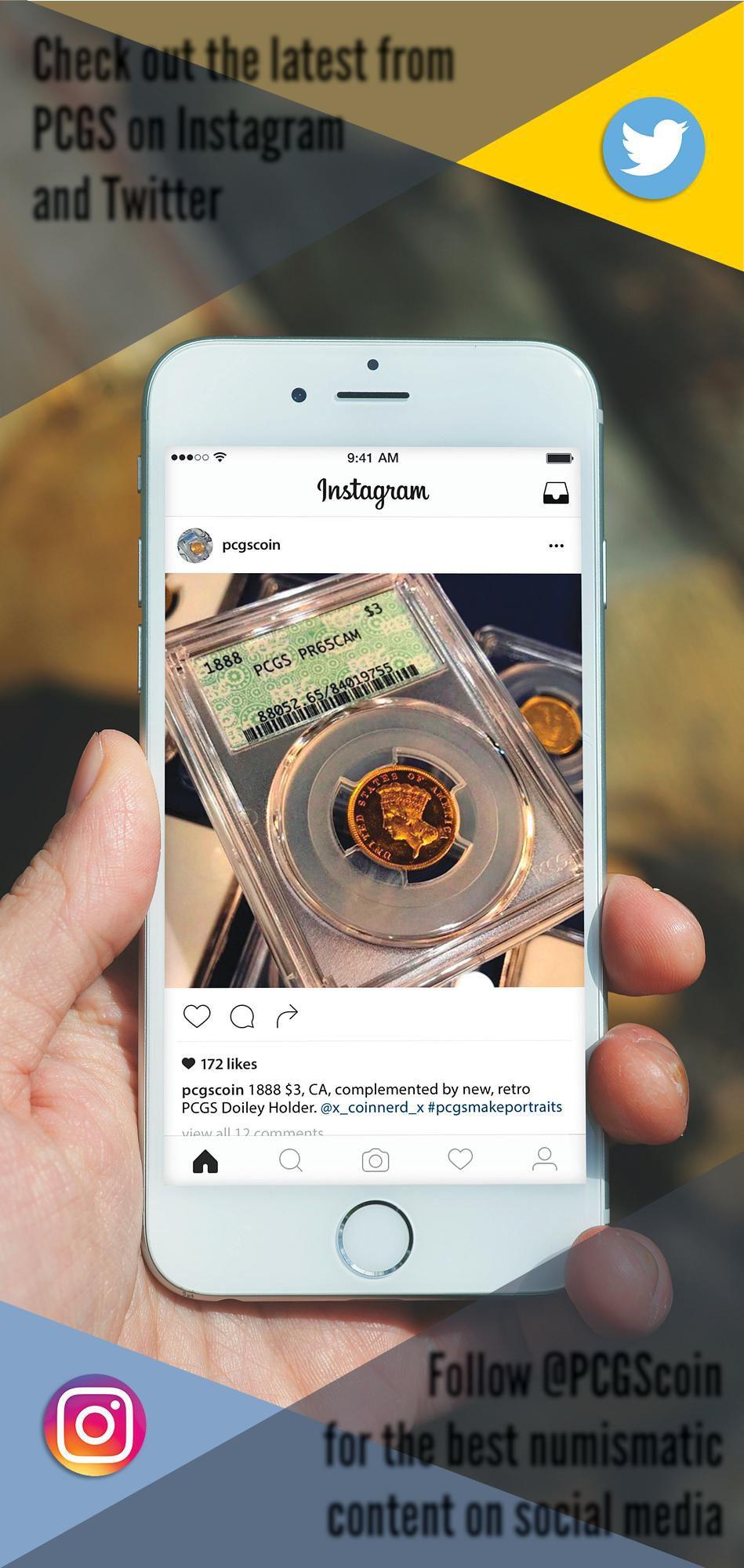

The PCGS Rare Coin Market Report is published bi-monthly by the Professional Coin Grading Service (PCGS.) The prices listed in the PCGS Rare Coin Market Report Price Guide are meant to serve as a guide to assist the rare coin buying public in determining values for all significant United States coins. Before you use the PCGS Rare Coin Market Report Price Guide, you should read the following information very carefully.
very carefully
The prices listed in the PCGS Rare Coin Market Report Price Guide are average dealer asking prices for PCGS-graded United States coins. The prices are compiled from various sources, including dealer ads in trade papers, dealer fixed price lists and websites, major auctions, and activity at major coin shows. The prices are what you should expect to pay, on average, for PCGS-graded coins. Note that RCMR prices do not apply to coins which have not been graded by PCGS, coins which have been graded by other grading services, or non-third party graded coins where the grade is represented by the seller, may not have been graded by the same standards as PCGS-graded coins and their market value may be different.
asking prices for PCGS-graded United States coins The prices are compiled from various sources, dealer ads in trade papers, dealer fixed lists and websites, auctions, and at coin shows The are what you should expect to pay, on

Prices for U.S. rare coins can and do change frequently. Prices for more generic issues can move weekly and even daily. The PCGS Rare Coin Market Report is a bi-monthly publication and is subject to lead times for printing and mailing. Prices listed in the RCMR are derived from the more comprehensive PCGS Online Price Guide (www.pcgs.com). RCMR prices are the prices listed in the PCGS Online Price Guide the day the RCMR is sent to the printer. For up-to-date prices, check the PCGS Online Price Guide on www.pcgs.com/prices.

Some U.S. coin prices are very sensitive to movements in the price of silver, gold, and platinum, and the prices of these metals change daily. Bullion-sensitive U.S. coins include most silver, gold and platinum Eagles, gold Buffalo, lower-grade examples of the more common date pre-1933 U.S. gold coins, and some modern gold commemoratives. As of October 2017, metals prices were approximately:
Gold: $1,285 Silver: $17.10 Platinum: $930
Price changes are indicated by an arrow to the right of the price. A green arrow pointing up indicates a price that has moved up since the previous issue of the RCMR. A red arrow pointing down indicates a price that has moved down since the previous issue of the RCMR
The PCGS Rare Coin Market Report Price Guide lists prices for all regular issue and commemorative United States coins minted from 1792 to date. Prices are listed for regular strikes, proofs and some special strikes. Prices are listed for all dates and mint marks and all major varieties. Prices are also listed for “type.” This listing appears at the start of each section for each type of coin and refers to the price for the most common date of a particular type.
There are 30 grades used by PCGS to grade coins, 1 being the lowest grade and 70 being the highest grade. Space considerations do not allow the PCGS Rare Coin Market Report to list prices for every grade. Consequently, the RCMR lists prices for up to 10 grades for individual coins. Grades listed are at intervals that should be the most useful to coin buyers. For “in-between” grades, readers should refer to the PCGS Online Price Guide. The RCMR lists prices at the highest end of the grading scale for the highest grade known, either
graded by PCGS or known to exist in that grade. The RCMR does not list prices for fantasy grades, i.e. grades higher than are known to exist for a certain coin. The RCMR lists prices for coins with special striking designations, such as full bands, red color, prooflike surfaces, etc. For a description of all the grades and designations used in the RCMR, refer to the PCGS Grading Standards listed in this issue.
The PCGS Rare Coin Market Report Price Guide lists complete set prices for many coin series. There are three types of complete set prices. A “date set” is a set of one of each date of a particular series. A “date and mint mark” set is a set that includes every date and mint mark in a series. A “with major varieties” set is a set with one of every date, mint mark and major variety. Prices for complete sets are listed “per grade,” i.e. the price for the complete set if every coin in the set was in the particular grade listed.
Besides prices for every coin, the PCGS Rare Coin Market Report Price Guide lists the PCGS population, i.e. the number of coins graded by PCGS, for each coin.
The coin market is volatile and thinly capitalized. Significant short-term price swings are always possible. Collectors Universe, its principals, and representatives do not guarantee a profit nor guarantee against a loss for any coin you buy or sell based on the information in the PCGS Rare Coin Market Report Price Guide Collectors Universe, its principals and representatives also do not guarantee the accuracy of the information in the PCGS Rare Coin Market Report Price Guide. You buy and sell rare coins at your own risk. The following are the general grading standards for both regular strikes and proofs.
does not us to show a but those interested in a detailed look at all U S coins in all grades are referred to PCGS’s Photograde

Space does not permit us to show a comprehensive photographic grading guide here, but those interested in a detailed look at virtually all U.S. coins in all grades are referred to PCGS’s Photograde section, found at www.pcgs.com/photograde.
Strike
The completeness/incompleteness of a coin’s intended detail when originally struck.

Luster
For regular strikes, the primary attribute for circulated grades, i.e. Poor (PO1) to About Uncirculated (AU58), is the amount of wear or the amount of the original design detail that is still evident. Other attributes contributing to the grade for circulated regular strikes are surface preservation and eye appeal, either of which can be positive, negative or neutral and which affect the grade accordingly. For regular strikes in Uncirculated condition (MS60 to MS70), there are four primary attributes that determine grade: marks, strike, luster and eye appeal.

For strikes, the attribute for circulated i e Poor to About Uncirculated is the amount of wear or the amount of the detail that is still evident. Other attributes to the for circulated strikes are surface and eye either of which can be or neutral and which affect the accordingly For strikes in Uncirculated condition to MS70), there are four attributes that determine
The strength and pattern of light reflected off a coin.
The condition of the surface of a coin notably marks and/or scratches.
The element that “grabs” the viewer. The overall look of a coin. Often manifested as “toning.”
A PCGS MS70 shows no imperfections under five-power magnification. Must be 100% fully struck and have full original luster and outstanding eye appeal.
A PCGS MS69 will show only one or two miniscule imperfections. Must be fully struck and have full original luster and eye appeal.
A PCGS MS68 will have some extremely minor imperfections. Must be sharply struck, have full original luster and good eye appeal.
A PCGS MS67 will have some minor imperfections (marks, abrasions, etc). Must be well struck and have good luster and eye appeal.
A PCGS MS66 will have a few marks and/ or abrasions. The strike, luster, and eye appeal must be good.
A PCGS MS65 will have some marks and/ or abrasions, but they will be minor. The strike must be above average, and luster and eye appeal must be good.
A PCGS MS64 will have some marks and/ or abrasions, and they may be significant. The strike and eye appeal should be average or above and must not be negative. Luster may be somewhat subdued.
A PCGS MS63 will have marks and abrasions that are moderate in number and/or size. Strike may not be full and eye appeal can be slightly negative. Luster may be somewhat dull.
A PCGS MS62 will have no wear on high points. There may be considerable marks and abrasions and some may be severe. Strike may not be full and eye appeal may be negative. Luster may be dull.
A PCGS MS61 will have no wear on the high points. There may be multiple heavy marks and abrasions. Strike may not be full, luster may be dull, and/or eye appeal may be negative.
A PCGS MS60 will have no wear on the high points. There may be many heavy marks and abrasions. Strike may not be full, luster may be very dull, and/or eye appeal may be quite negative.
A PCGS AU58 will show full detail with minor friction on only the highest points.
A PCGS AU55 will show full detail with friction on less than 1/2 of the surface, mainly on the high points.
A PCGS AU53 will show full detail with friction on 1/2 or more of the surface. There may be a very slight flatness on high points.
A PCGS AU50 will show full detail with friction over most of the surface and slight flatness on high points.
XF45 Detail is complete with most high points slightly flat.
XF40 Detail is complete with some high points flat.
VF35 Detail is 80 to 85% complete.
VF30 Detail is 70 to 80% complete.
VF25 Detail is 60 to 70% complete.
VF20 Detail is 50 to 60% complete.
F15 Detail is full in recessed areas. All lettering is sharp.
F12 Detail is evident in deeply recessed areas. Lettering is mostly sharp.
VG10 Design is worn with some detail evident.
VG8 Design is worn with only slight detail evident.
G6 Detail is flat, but rims are complete. Peripheral lettering is full.
G4 Detail is flat. Rims slightly worn. Peripheral lettering nearly full.
AG3 Rims are worn but most lettering is readable though worn.
FR2 Mostly worn, but some design details are visible.
PO1 Barely identifiable as to date and type.

For proof strikings, the primary attributes of grade are hairlines and/or marks (or lack of), reflectivity (for brilliant proofs), and eye appeal. Note that nearly all proofs are fully struck, thus strike is usually not a factor. Strike only comes into play when a proof shows a partial strike, resulting in a downward adjustment of grade. Note that for toned brilliant proofs, the reflectivity is as perceived under toning.
A PCGS PR70 shows no imperfections under five-power magnification. Brilliant proofs must be 100% fully reflective.
A PCGS PR69 will show only one or two miniscule imperfections. Brilliant proofs must be 100% fully reflective.
A PCGS PR68 will have some extremely minor imperfections. Eye appeal must be outstanding. Brilliant proofs will be fully reflective.
A PCGS PR67 will have some minor imperfections (hairlines or perhaps an extremely minor mark or two). Eye appeal must be very good. Brilliant proofs must be fully reflective or virtually so.
A PCGS PR66 will have a few hairlines and/or very minor marks. Eye appeal must be very good. Brilliant proofs must be fully reflective or nearly so.
A PCGS PR65 will have minor hairlines and or minor marks. Eye appeal must be positive. Brilliant proofs must show good reflectivity.
A PCGS PR64 will have noticeable hairlines and/or small marks. Eye appeal must not be negative. Brilliant proofs may have subdued reflectivity.
A PCGS PR63 will have obvious hairlines and/ or marks. Eye appeal may be somewhat negative. Brilliant proofs may be dull.
A PCGS PR62 will have numerous hairlines and/or marks. Eye appeal may be quite negative. Brilliant proofs may be dull.
A PCGS PR6l will have lots of hairlines and/or marks. Eye appeal is negative. Brilliant proofs may not be reflective.
A PCGS PR60 will have no wear on the high points, but will be very hairlined and/ or marked. Eye appeal is negative. Brilliant proofs may not be reflective.
Proofs below PR60 For proof strikings grading below PR60, the grading is based on the amount of wear and the standards are the same as for regular strikes.
In addition to grade, certain coins have characteristics that collectors recognize as important and PCGS designates these characteristics using the standards that follow.




Brown (BN) PCGS designates Brown for copper coins that have less than 5% of their original mint red color.

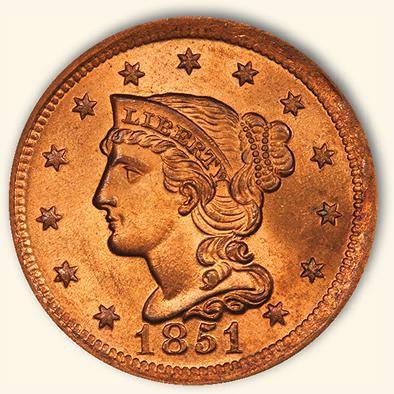





Full Steps (FS) PCGS designates full steps for Jefferson nickels that grade MS60 or better and show a full five or six steps in the portrait of Monticello (Thomas Jefferson’s home) on the reverse. To qualify for this designation, a coin must also have no major disturbances, including cuts and marks, to the separation of the steps.
Full Bands (FB) PCGS designates full bands for Roosevelt dimes that grade MS60 or better and show full separation of the upper and lower horizontal bands of the torch on the reverse. To qualify for this designation, a coin must also show no significant cuts or marks across the horizontal bands.

Red Brown (RB) PCGS designates Red and Brown for copper coins that grade MS60 or better and show between 5% and 95% of their original mint red color.
Full Bands (FB) PCGS designates full bands for Mercury dimes that grade MS60 or better and show full separation of the central crossbands on the crossbands on the reverse. To qualify for this designation, a coin must also have no major disturbances, including cuts and marks, of the separation of the crossbands.
Red (RD) PCGS designates Red for copper coins that grade MS60 or better and show 95% or more of their original mint red color.
Full Head (FH) PCGS designates full head for Standing Liberty quarters that grade AU50 or better and show full detail of Ms. Liberty’s hair (on Type Ones) or helmet (on Type Twos); Type Ones (1916-1917) must show a distinct separation between the hair cords and the cap. Type Twos (1917-1930) must show three complete and distinct leaves to the helmet, a complete outline to the bottom of the helmet, and a distinct ear hole. Note that on the ultra rare 1918/7-S, PCGS will designate full head on coins that grade XF40 or better and that meet the full head criteria.
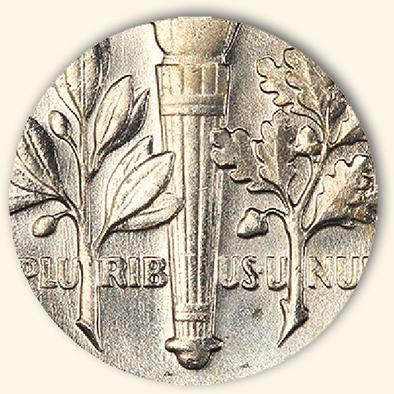




Full Bell Lines (FBL) PCGS designates Full Bell Lines for Franklin half dollars that grade MS60 or better and show full separation of the lines on the bottom of the Liberty Bell on the reverse. To qualify for this designation, a coin must also show no major disturbances, including cuts and marks, of the separation of the bell lines.

Deep Mirror Prooflike (DMPL) PCGS designates deep mirror Prooflike for Morgan dollars that grade MS60 or better and show deep reflectivity, i.e. deeply mirrored surfaces. The differences between PL and DMPL is one of degree.

Prooflike (PL) PCGS designates Prooflike forMorgandollarsthatgradeMS60orbetter and show clear reflectivity, i.e. mirrored surfaces at a distance of two to four inches. If the cartwheel effect or striations cause an area to lose clarity, the designation will not apply.
Cameo (CA) PCGS designates cameo for brilliant proofs that show light to moderate frosting of the devices. Both sides of a coin must have frosted devices to earn the cameo designation.
PCGS does not grade coins that are counterfeit, have been artificially toned, have had their surfaces altered, have been environmentally damaged, have been abrasively cleaned, have extremely large scratches, or have been repaired. Some allowances are made for ultra rarities, colonials and territorial gold coins, in which there are some instances when “net grading”isusedbyPCGSasaservicetothe numismatic community.

No grade coins returned to the submitter with encapsulation.
Code Reason 82 Filed Rims
Questionable Color 92 Cleaning
Planchet Flaw
Altered Surfaces
Stratch(s)
Environmental Damage
Damage No PCGS Holder No grade coins returned to the submitter without encapsulation. Code Reason
Lamination
Unverifiable
Counterfeit
Service
PVC Residue Would you like further information about the PCGS Grading Standards, Designations and No Grade Standards? View high-resolution images and in-depth videos for each at www.PCGS.com/grades.
Deep Cameo (DCAM) PCGS designates deep cameo for brilliant proofs that display deep, even frosting on the devices of both sides of the coin.
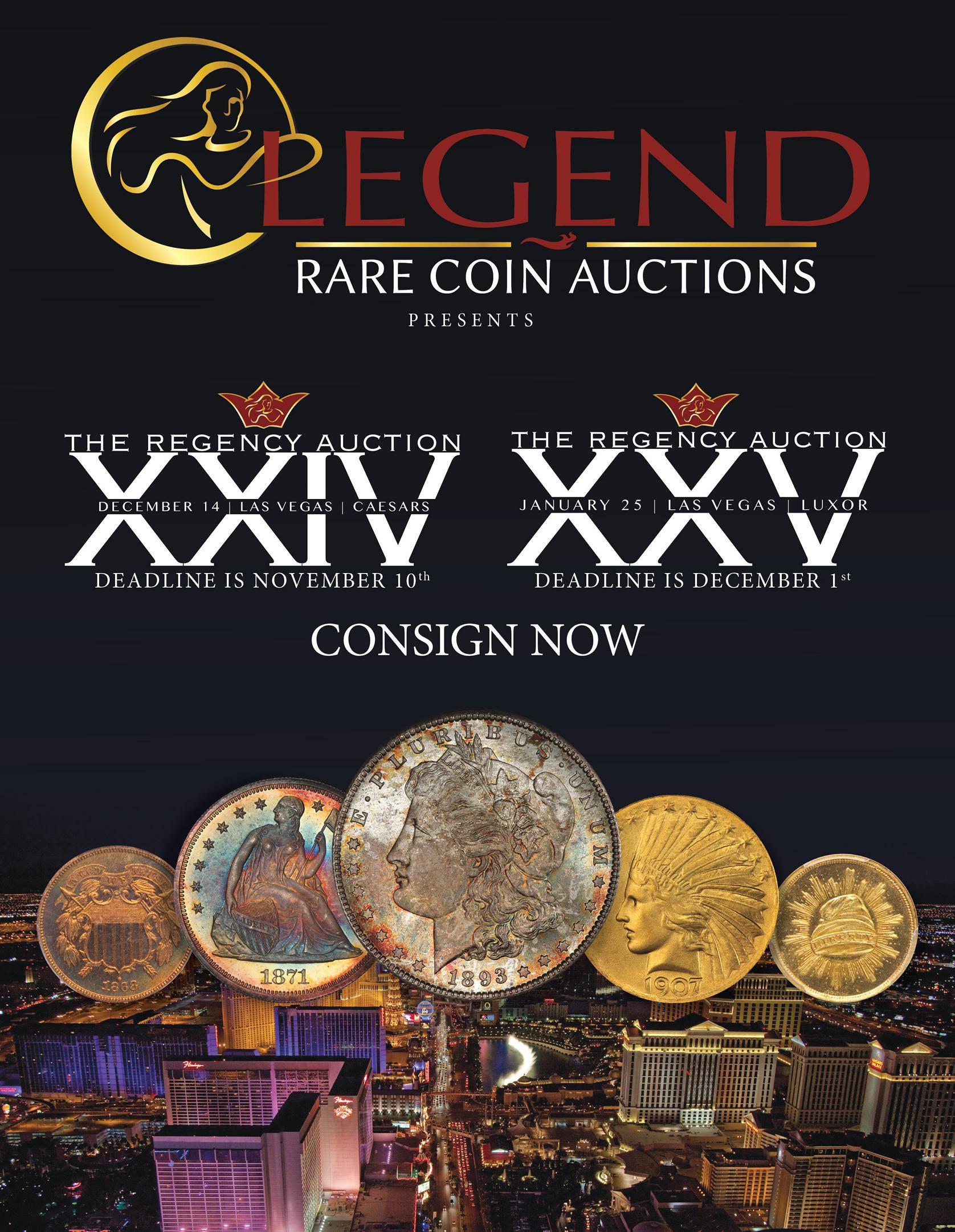

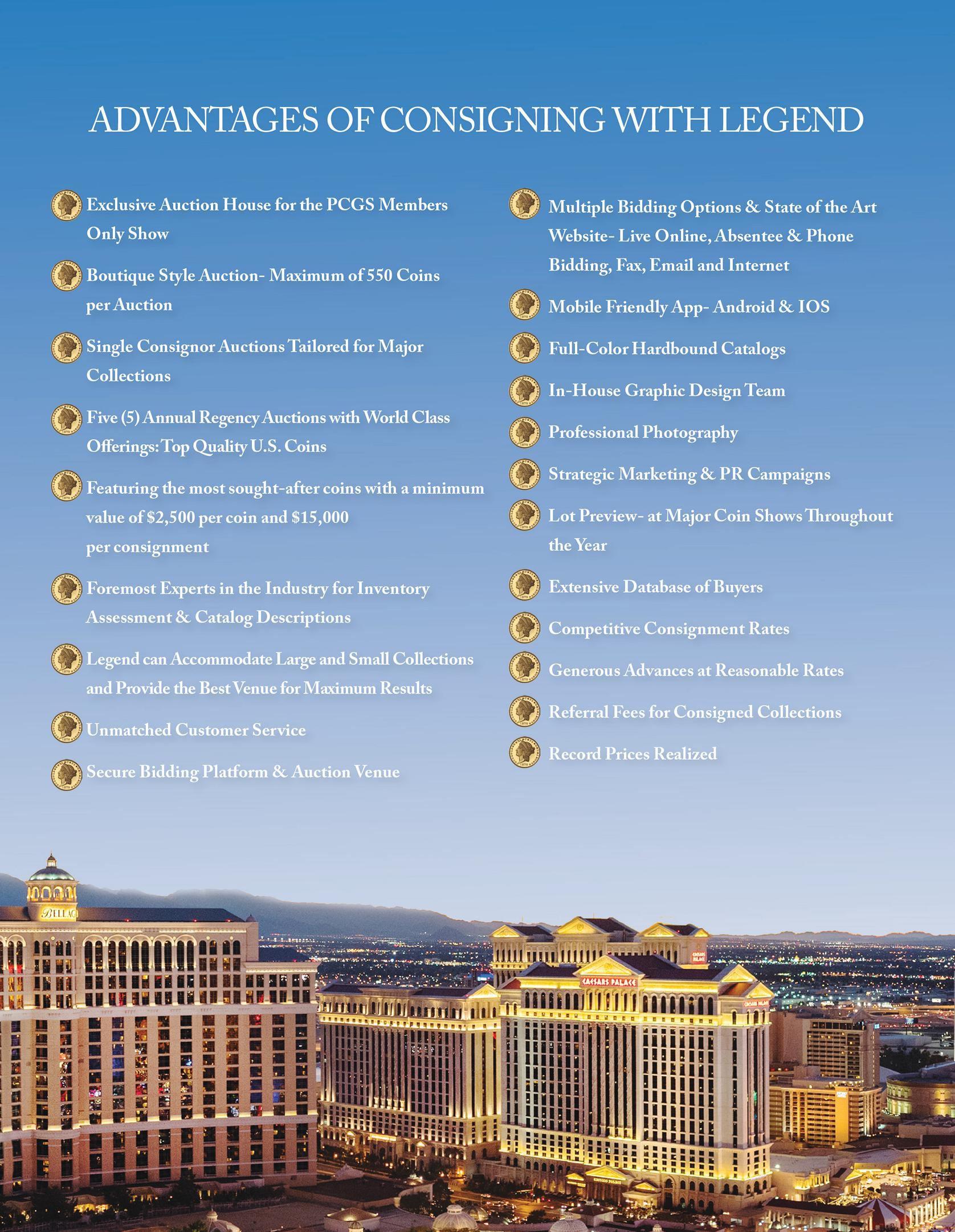
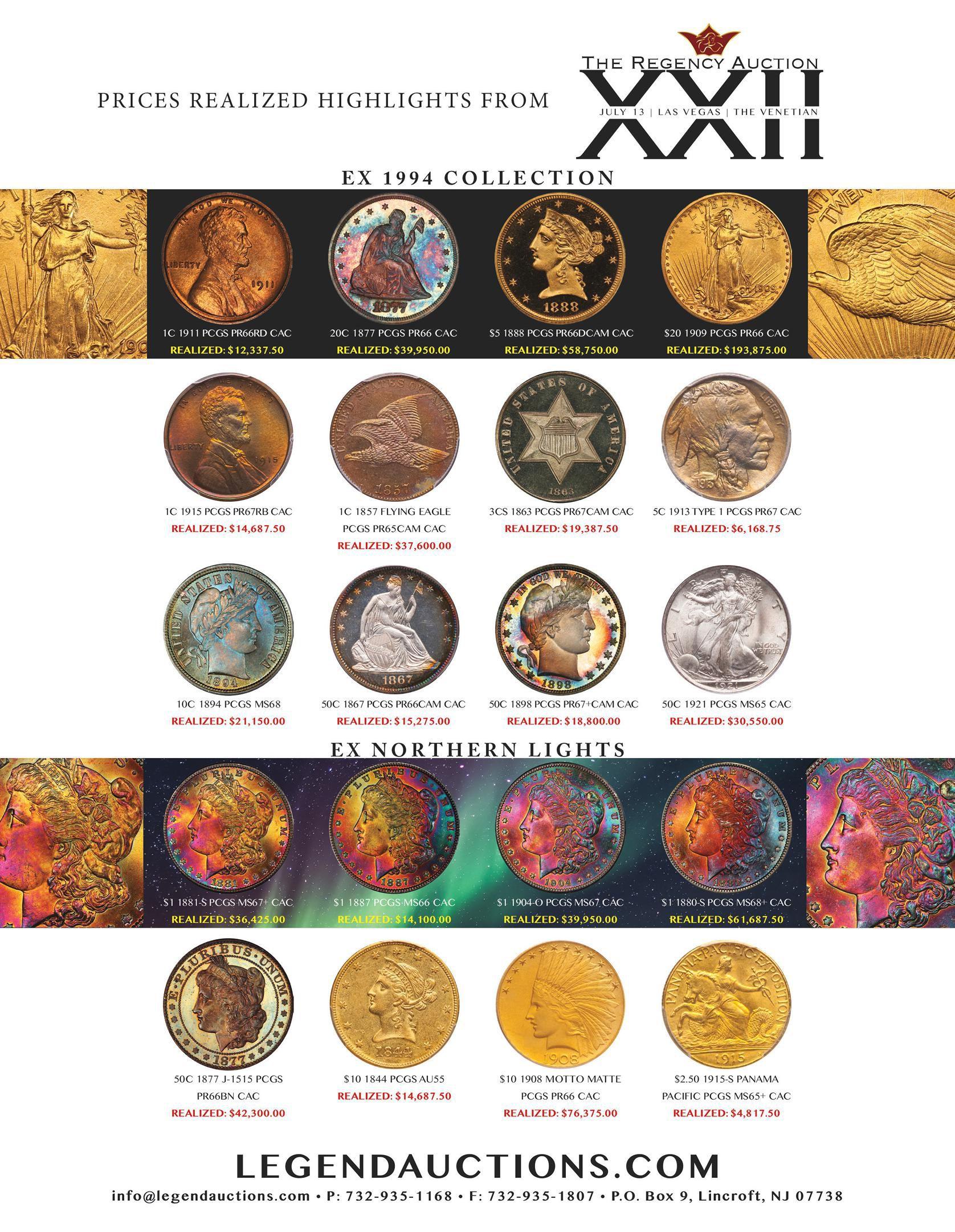


In every issue, we’ll be using this column to showcase a few of the truly extraordinary coins that come through our grading room. PCGS sees a lot of coins every month, and after almost 32 years in the business it takes something quite unusual and special for our graders to really get excited. That said, we’d like to share a couple of the really interesting pieces we’ve had the privilege to grade this month.
There are so many things going on here to make this a stand-out treasure. First, this coin has a pedigree tracing back to the New Orleans Mint’s Chief Coiner, William J. Brophy. This coin may have been presented to him. If he didn’t receive the coin, he attested that it was the first 1904-O off the mint presses that year.
It’s clear it is a specially-made piece because the surfaces reflect carefully prepared dies. The dies were not acid treated to produce a proof. However, mint employees prepared the minting equipment and dies to give this coin a beautiful strike and outstanding surfaces.
It is this clear special preparation that led our graders to recently upgrade the coin from PCGS MS68 to PCGS SP68. The new grade signifies it is a special strike.
The coin’s presentation also makes it special. Through the 1970s, the coin's owner kept it in a diminutive yellow envelope describing the Brophy Pedigree. In the 1990s, when PCGS first certified this beautiful coin, we placed it in a Regency Holder. This is also significant because we didn't make many of these special holders, and few remain today. The Regency Holder was set aside for truly special coins and only used between 1992 and 1996. The envelope remains with the coin and the coin remains in its original Regency holder. We've updated the population figures to reflect the new grade.


All in all, this is one of those truly rare coins we enjoy getting to see!
Third-Known Two-Reverse Clad Quarter, PCGS MS62
Well now this isn’t something we see every day! And we’re not alone, seeing as we only know of three that exist.
Error Dealer Fred Weinberg came up with this find and submitted it to us recently. He sent this piece along with a 1968 90% Silver Proof Washington Quarter, but that’s another story.
There are many two-tailed coins made for amusement. Most are two coins, cleverly ground down to half a coin and then joined at the seam. They’re discernible usually as the seam joining the coins is often quite clear.
Thishowever,isagenuineMintproduct,likelyproduced either intentionally or in error by a U.S. Mint employee.
Unfortunately, by the nature of two reverse dies only, there is no date on the coin. Based on careful examination of the reverse dies used, our Washington Quarter specialists believe the mint created this error coin between 1965 and 1967. It is of “clad”, or copper-nickel composition that the Mint used from 1965 on. The mint struck the coin with dies aligned in standard coin alignment. By all accounts, the graders agree that this is one of the coolest coins to come through the grading room recently.
My name is Owen Seymour and I am a 19-yearold coin dealer from Pennsylvania. I own and operate my business travelling the United States, buying and selling U.S. coins. My initial interest in coins is a story similar to many — my father was a coin collector, and something about them was inherently fascinating to me as a child. What makes me different from previous generations of dealers, however, is that instead of getting my start by dealing at coin shops and on bourse floors, I turned to social media to jumpstart my career.

Ever since I can remember, I always dreamt of owning my own business. Several coin dealers encouraged me to consider actively buying and selling coins and would constantly remind me, “People your age are the next generation of numismatics, and there have to be dealers!” But it seemed like such a fantasy to me. I had no clue where to start — where do I buy coins wholesale? I can’t open my own store, I thought to myself, so how do I establish a reputation necessary to sell online? How will I handle tax preparation, if necessary? It was all very intimidating!
My vision became a reality one day when I was scrolling through Instagram and saw a young kid, around my age, selling a coin on the site. I clicked on the account and it was a numismatics-dedicated account, with tons of active buyers! I found it fascinating that a platform so simple could be used to efficiently buy and sell coins. That day I created my own numismatics-dedicated account @PA_Coins. Within a week I had several sales of pieces from my own collection, and had made a fair profit. I used PayPal’s mutual buyer and

seller protection to establish a reputation for myself, both on Instagram and as a coin dealer in general.
Today, I have been lucky enough to establish and operate a successful business buying and selling coins. I buy mostly from coin shops and or shows, and sell almost entirely online, where I’m still very active on Instagram. I follow and engage with accounts like @PCGScoin. I also maintain an email dealer-only wholesale list, which I have been gravitating toward as I continue to submit more and more coins to PCGS. I graduated from high school in spring of 2016 and have focused entirely on coins ever since, and I am ecstatic to say coins have not only been a love and hobby, but have also provided me a career.
“The hobby is dying/dead!” is a commonly recited claim made by both hobbyists and dealers, and it is really not the case. My Instagram account — @PA_Coins — has amassed over 6,000 followers, a considerable portion of which are under the age of 18! I have sold thousands of coins to kids who are deeply in love with collecting, some as young as 12 years old. It is very often that a message will pop up in my folder from a young person expressing their interest in my page, saying even though they have never collected coins before, they would appreciate my guidance on how to become involved in coins!
There is a massive web of teenagers and young adults all across the United States dealing coins. The knowledge, experience, and professionalism expressed by these individuals is amazing, especially considering their age. I know12-year-oldswhocanruncirclesaroundmealldaylong when it comes to errors and varieties, and 14-year-olds who can grade raw coins with considerable accuracy. I can think of several online coin dealers who will become important and respected individuals in the near future of this hobby, and are already on their way to doing so.
If you evaluate the health of our hobby by analyzing the attendance of youth at coin shows or coin shops, it will appear that youth is rarely involved, if at all. However, if you examine the presence and activity of youth on the internet by analyzing platforms such as Instagram, Facebook, and chat forums, it will quickly become apparent that the hobby is thriving among youth and has an undeniably bright future.
“I have sold thousands of coins to kids who are deeply in love with collecting, some as young as 12 years old.”
November 9 - 11
Whitman Baltimore Expo
On-Site Grading | Stack’s Bowers Auction Baltimore, MD
DECEMBER
December 13 - 16
PCGS Members Only Show
On-Site Grading | Regency Auction Las Vegas, NV (Caesars Palace)
JANUARY 2018
January 4 - 6
F.U.N. Convention
On-Site Grading | Heritage Auction Tampa, Florida
January 11 - 13
NYINC
Submissions Only New York, NY
FEBRUARY
February 22 - 24
Long Beach Expo
On-Site Grading | Heritage Auction Long Beach, CA
MARCH
March 8 - 10
ANA National Money Show Submissions Only Irving, TX
March 22 - 24
Whitman Spring Expo
On-Site Grading | Stack’s Bowers Auction Baltimore, MD
APRIL
April 11 -14
PCGS Members Only Show
On-Site Grading Las Vegas, NV (Venetian | Palazzo)
April 25 - 28
Central States Numismatic Society Submission Only | Heritage Auction Schaumburg, IL

MAY May 16 - 19
PCGS Members Only Show
On-Site Grading New Orleans, LA (Harrah's)
JUNE
June 14 - 16
Long Beach Expo
On-Site Grading | Heritage Auction Long Beach, CA
June 21 - 23
Whitman Summer Expo
Submission Only | Stack's Bowers Auction Baltimore, MD
For more information visit PCGS.com/shows
JULY
July 12 - 14
Summer F.U.N. Show Submissions Only Orlando, FL
July 25 - 28
PCGS Members Only Show
On-Site Grading Las Vegas, NV (Caesars Palace)
AUGUST
August 13
PNG/ANA Numis. Trade Show
On-Site Grading Philadelphia, PA
August 14 - 18
ANA World's Fair of Money
On-Site Grading | Stacks Bowers Auction Philadelphia, PA
September 6 - 8
Long Beach Expo
On-Site Grading | Heritage Auction Long Beach, CA
September 26 - 29
PCGS Members Only show
On-Site Grading Las Vegas, NV (Cosmopolitan)
After the Lincoln Cent, the Morgan Dollar is probably the most avidly collected series in U.S. numismatics. Due to their prodigious mintage and relatively light usage, many thousands were preserved in Mint State, and offer today’s collector a large, attractive silver coin over a century old for an extremely modest price.
However, that modest price does not extend to all dates and mints. After the heavy mintages of the late 1870s and 1880s, production fell off sharply in the early and mid 1890s, resulting in some extremely rare coins in the Morgan Dollar series.
Probably the King of them all is the 1893-S. With a miniscule mintage (by Morgan Dollar standards) of only 100,000 pieces, it commands a price of several thousand dollars regardless of grade. Like many other dates in this series, as you approach and cross the “Mint State” barrier, rarity (and price) go through the roof.
While an estimated 10% of the original mintage survives in all grades, only about 1% (or about 100 pieces) survive in MS-60 or better. And of those, probably just under 10% would qualify as MS-65 or higher. Any bags that may have been stored in the Treasury were almost certainly melted under the 1918 Pittman Act. No large holdings of 1893-S dollars in mint state have ever surfaced.
Sowhatweendupwithisperhaps6-8GemUncirculated coins in an extremely popular series. And that’s the key. Six to eight gems of a particular date and mint might suffice in a series like Seated Half Dimes, but in a series like Morgan Dollars, it’s simply not enough.
Gem examples of 1893-S Dollars now trade for around half a million dollars, but among these few gems, one in particular stands head and shoulders above the rest. It is the incredible PCGS MS-67 presently in the Coronet Collection on the Set Registry, and now due to be auctioned by Legend in their Regency XXIII Auction in Philadelphia on October 26.
Originally from the collection of Cornelius Vermeule I, it passed through two generations of that family until it was sold by Cornelius Vermeule III in a September 2001 Stacks sale where it realized $414,000. It was purchased by noted silver dollar collector Jack Lee, whereby upon his death in 2008, it passed to its present owner (the Coronet Collection).

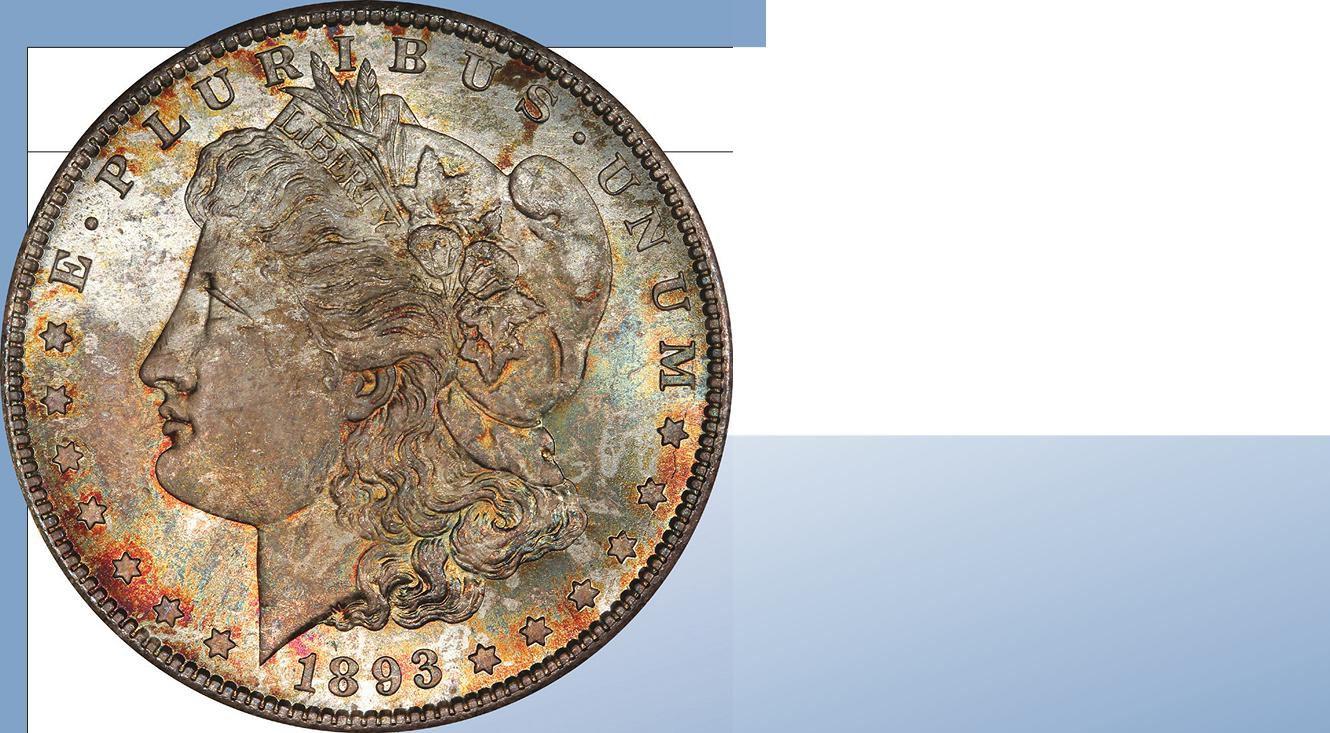
Regardless of the result of the auction (which by the time this is being read, will be history) it is a noteworthy and important offering, and hopefully the new owner will enjoy his or her ownership of the finest-known example of the King of the Morgan Dollars!
